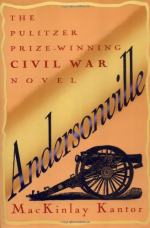The stump Andrews and I had the foresight to save now did us excellent service. It was pitch pine, very fat with resin, and a little piece split off each day added much to our fires and our comfort.
One morning, upon examining the pockets of an infantryman of my hundred who had just died, I had the wonderful luck to find a silver quarter. I hurried off to tell Andrews of our unexpected good fortune. By an effort he succeeded in calming himself to the point of receiving the news with philosophic coolness, and we went into Committee of the Whole Upon the State of Our Stomachs, to consider how the money could be spent to the best advantage. At the south side of the Stockade on the outside of the timbers, was a sutler shop, kept by a Rebel, and communicating with the prison by a hole two or three feet square, cut through the logs. The Dead Line was broken at this point, so as to permit prisoners to come up to the hole to trade. The articles for sale were corn meal and bread, flour and wheat bread, meat, beaus, molasses, honey, sweet potatos, etc. I went down to the place, carefully inspected the stock, priced everything there, and studied the relative food value of each. I came back, reported my observations and conclusions to Andrews, and then staid at the tent while he went on a similar errand. The consideration of the matter was continued during the day and night, and the next morning we determined upon investing our twenty-five cents in sweet potatos, as we could get nearly a half-bushel of them, which was “more fillin’ at the price,” to use the words of Dickens’s Fat Boy, than anything else offered us. We bought the potatos, carried them home in our blanket, buried them in the bottom of our tent, to keep them from being stolen, and restricted ourselves to two per day until we had eaten them all.
The Rebels did something more towards properly caring for the sick than at Andersonville. A hospital was established in the northwestern corner of the Stockade, and separated from the rest of the camp by a line of police, composed of our own men. In this space several large sheds were erected, of that rude architecture common to the coarser sort of buildings in the South. There was not a nail or a bolt used in their entire construction. Forked posts at the ends and sides supported poles upon which were laid the long “shakes,” or split shingles, forming the roofs, and which were held in place by other poles laid upon them. The sides and ends were enclosed by similar “shakes,” and altogether they formed quite a fair protection against the weather. Beds of pine leaves were provided for the sick, and some coverlets, which our Sanitary Commission had been allowed to send through. But nothing was done to bathe or cleanse them, or to exchange their lice-infested garments for others less full of torture. The long tangled hair and whiskers were not cut, nor indeed were any of the commonest suggestions for the improvement of the condition of the sick put into execution. Men who had laid in their mud hovels until they had become helpless and hopeless, were admitted to the hospital, usually only to die.




